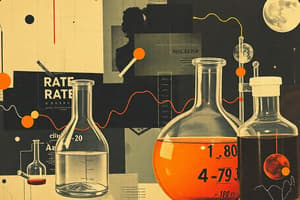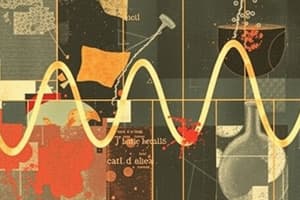Podcast
Questions and Answers
What is the most common unit used to express reaction rate?
What is the most common unit used to express reaction rate?
- Moles per liter per minute (M/min)
- Atmospheres per second (atm/s)
- Atoms per second
- Grams per second (g/s)
- Moles per liter per second (M/s) (correct)
Which of the following statements about reaction rate is true?
Which of the following statements about reaction rate is true?
- The rate of a reaction depends only on temperature.
- Reaction rates must always be determined experimentally. (correct)
- The rate of disappearance of reactants is always reported as negative.
- Reaction rate can be negative.
- The rate law is determined from the balanced equation.
In the reaction A + B → 2C, how does the rate of disappearance of A compare to the rate of formation of C?
In the reaction A + B → 2C, how does the rate of disappearance of A compare to the rate of formation of C?
- No relationship
- The same
- Twice as fast
- Four times as fast
- Half as fast (correct)
What does the rate law describe?
What does the rate law describe?
What does the rate constant (k) depend on?
What does the rate constant (k) depend on?
If a reaction is zero order in reactant A, how does the rate change when A is doubled?
If a reaction is zero order in reactant A, how does the rate change when A is doubled?
A reaction is first order in [A]. What happens to the rate when [A] is tripled?
A reaction is first order in [A]. What happens to the rate when [A] is tripled?
A second-order reaction is one where:
A second-order reaction is one where:
The half-life equation $t_{1/2} = 0.693/k$ applies only to:
The half-life equation $t_{1/2} = 0.693/k$ applies only to:
Which of the following is NOT a valid unit for the rate constant (k)?
Which of the following is NOT a valid unit for the rate constant (k)?
According to collision theory, which condition is NOT necessary for a reaction to occur?
According to collision theory, which condition is NOT necessary for a reaction to occur?
Increasing the temperature of a reaction generally:
Increasing the temperature of a reaction generally:
A catalyst affects a reaction by:
A catalyst affects a reaction by:
The rate-determining step is:
The rate-determining step is:
What is the molecularity of the reaction step: A + B → C?
What is the molecularity of the reaction step: A + B → C?
In the two-step mechanism below, which step determines the rate law?
In the two-step mechanism below, which step determines the rate law?
Which of the following is an example of a reaction intermediate?
Which of the following is an example of a reaction intermediate?
The slowest step in a reaction mechanism:
The slowest step in a reaction mechanism:
Which of the following describes a catalyst?
Which of the following describes a catalyst?
Which step in a mechanism will determine the rate law?
Which step in a mechanism will determine the rate law?
If the temperature of a reaction increases, the reaction rate generally:
If the temperature of a reaction increases, the reaction rate generally:
A catalyst:
A catalyst:
Which of the following statements is true about reaction intermediates?
Which of the following statements is true about reaction intermediates?
For a reaction following a second-order rate law, which unit is correct for the rate constant (k)?
For a reaction following a second-order rate law, which unit is correct for the rate constant (k)?
What happens to the reaction rate if the reactant concentration is halved in a first-order reaction?
What happens to the reaction rate if the reactant concentration is halved in a first-order reaction?
The half-life of a first-order reaction:
The half-life of a first-order reaction:
The integrated rate law for a first-order reaction is:
The integrated rate law for a first-order reaction is:
The half-life equation $t_{1/2} = 0.693/k$ is derived from:
The half-life equation $t_{1/2} = 0.693/k$ is derived from:
If a reaction has a rate law of rate = k[A]²[B], what is the overall order of the reaction?
If a reaction has a rate law of rate = k[A]²[B], what is the overall order of the reaction?
Which of the following factors does NOT affect the rate constant (k) of a reaction?
Which of the following factors does NOT affect the rate constant (k) of a reaction?
Flashcards
Learning Styles
Learning Styles
Different approaches or ways to learn, such as visual, auditory, or kinesthetic.
Visual Learning
Visual Learning
A style of learning where information is best understood through images, diagrams, and charts.
Auditory Learning
Auditory Learning
A learning style where sound, music, and spoken words enhance understanding.
Kinesthetic Learning
Kinesthetic Learning
Signup and view all the flashcards
Active Retrieval
Active Retrieval
Signup and view all the flashcards
Feedback Mechanism
Feedback Mechanism
Signup and view all the flashcards
Repetition Effect
Repetition Effect
Signup and view all the flashcards
Study Techniques
Study Techniques
Signup and view all the flashcards
Self-Assessment
Self-Assessment
Signup and view all the flashcards
Mind Mapping
Mind Mapping
Signup and view all the flashcards
Study Notes
Reaction Rates and Rate Laws
- Reaction rate unit: Moles per liter per second (M/s)
- Reaction rate truth: Reaction rates must be determined experimentally. The rate of disappearance of reactants is always reported as negative.
- Reaction rate comparison (A + B → 2C): The rate of disappearance of A is half the rate of formation of C.
Rate Law
- Rate law description: Describes how the rate depends on reactant concentrations.
- Rate constant (k) dependence: The rate constant (k) depends on temperature.
Reaction Order
- Zero-order reaction (reactant A doubled): The rate remains constant.
- First-order reaction ([A] tripled): The rate triples.
- Second-order reaction: The concentration of one reactant is squared in the rate law.
- Half-life equation applicability: Applies only to first-order reactions (t1/2 = 0.693/k).
Collision Theory and Activation Energy
- Necessary condition for reaction (collision theory): Proper molecular orientation and sufficient energy.
- Effect of increasing temperature: Increases the rate constant (k).
- Catalyst effect: Lowers the activation energy.
Reaction Mechanisms and Rate-Determining Steps
- Rate-determining step: The step with the highest activation energy.
- Reaction intermediate definition: A species formed in one step and consumed in another.
- Rate law determination step: The slowest step in the reaction mechanism.
Temperature Effects, Catalysts, and Reaction Kinetics
- Reaction rate and temperature relationship: Increasing temperature increases the reaction rate due to increased molecular collisions with higher energy and frequency.
- Catalyst effect: Provides an alternative reaction pathway with lower activation energy.
- Catalyst effect on equilibrium: Catalysts do not affect the equilibrium constant.
Half-Life and Integrated Rate Laws
- First-order reaction half-life: The half-life is constant, regardless of concentration.
- Integrated rate law for first-order reaction: ln[A]t = ln[A]0 - kt
- Unit for rate constant (k) in second-order reaction: 1/(M⋅s)
- Effect of reactant concentration halving in first-order reaction: The rate halves.
Studying That Suits You
Use AI to generate personalized quizzes and flashcards to suit your learning preferences.




